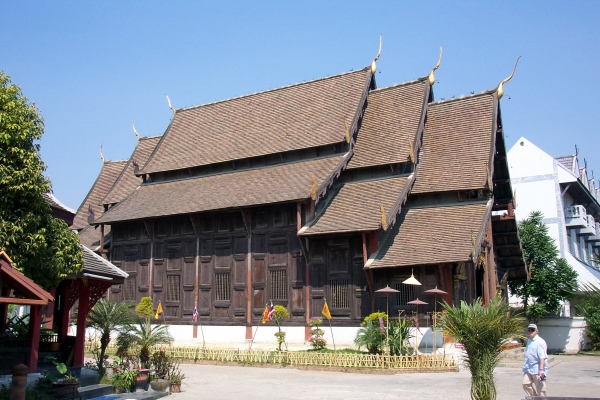Next to the well known temple of Wat Chedi Luang is a small interesting temple called Wat Pan Tao, which means "to increase 1,000 times." The temple was built around the same time as Wat Chedi Luang, in the late fourteenth century. It was one of four monastic temples serving the royal temple next door.

The elegant wooden wiharn of the temple
The temple's most interesting feature is its wooden wiharn, a chapel for lay people to pray in. The teak building was moved to the temple grounds in 1875 by King Inthawichayanon. It was formerly a royal residence, but the practice in Lanna was for each new king to built a new palace. The old palaces were often 'recycled' into other uses, especially in temples.
Over the main entry door on the east end of the chapel is a large gilded wood carving depicting a peacock flanked by several other animals, some of which are mythical. The peacock was the symbol of the kings of Chiang Mai; this carving has appeared on stamps and other materials celebrating Chiang Mai's 700th anniversary.

The main altar within the chapel of Wat Pan Tao
Within the wiharn are several interesting old artifacts, such as a dhamma casket. The ancient wooden box holds Buddhist scriptures written on palm leaves. A few sample 'books' are usually on display above the casket. The caskets are finished in black lacquer decorated with gold leaf. (When I re-visited the chapel in August 2007, the box wasn't there, but it may have just been moved temporarily)
Also on display is a tall pulpit-like stand, ornately carved and gilded. These structures, known as a busbok, are not used by priests, but are usually used to house important Buddha images.
You can take it with you.
Wish you could have this information with you when you visit Chiang Mai? Now you can. Check out our ebook guides.
The hall is also decorated with several tung prayer flags. Along one side is a platform for the monks to use during prayers, with all the priestly paraphernalia on display.